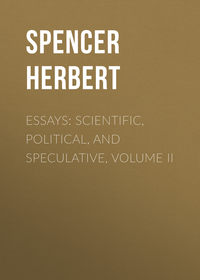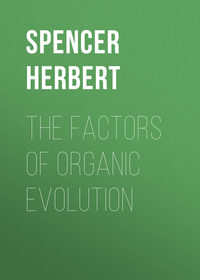 полная версия
полная версияThe Principles of Biology, Volume 1 (of 2)
CHAPTER VII.
THE SCOPE OF BIOLOGY
§ 37. As ordinarily conceived, the science of Biology falls into two great divisions, the one dealing with animal life, called Zoology, and the other dealing with vegetal life, called Botany, or more properly to be called Phytology. But convenient as is this division, it is not that which arises if we follow the scientific method of including in one group all the phenomena of fundamentally the same order and putting separately in another group all the phenomena of a fundamentally different order. For animals and plants are alike in having structures; and animals and plants are alike in having functions performed by these structures; and the distinction between structures and functions transcends the difference between any one structure and any other or between any one function and any other – is, indeed, an absolute distinction, like that between Matter and Motion. Recognizing, then, the logic of the division thus indicated, we must group the parts of Biology thus: —
1. An account of the structural phenomena presented by organisms. This subdivides into: —
a. The established structural phenomena presented by individual organisms.
b. The changing structural phenomena presented by successions of organisms.
2. An account of the functional phenomena which organisms present. This, too, admits of subdivision into: —
a. The established functional phenomena of individual organisms.
b. The changing functional phenomena of successions of organisms.
3. An account of the actions of Structures on Functions and the re-actions of Functions on Structures. Like the others, this is divisible into: —
a. The actions and re-actions as exhibited in individual organisms.
b. The actions and re-actions as exhibited in successions of organisms.
4. An account of the phenomena attending the production of successions of organisms: in other words – the phenomena of Genesis.
Of course, for purposes of exploration and teaching, the division into Zoology and Botany, founded on contrasts so marked and numerous, must always be retained. But here recognizing this familiar distinction only as much as convenience obliges us to do, let us now pass on to consider, more in detail, the classification of biologic phenomena above set down in its leading outlines.
§ 38. The facts of structure shown in an individual organism, are of two chief kinds. In order of conspicuousness, though not in order of time, there come first those arrangements of parts which characterize the mature organism; an account of which, originally called Anatomy, is now called Morphology. Then come those successive modifications through which the organism passes in its progress from the germ to the developed form; an account of which is called Embryology.
The structural changes which any series of individual organisms exhibits, admit of similar classification. On the one hand, we have those inner and outer differences of shape, that arise between the adult members of successive generations descended from a common stock – differences which, though usually not marked between adjacent generations, become great in course of multitudinous generations. On the other hand, we have those developmental modifications, seen in the embryos, through which such modifications of the descended forms are reached.
Interpretation of the structures of individual organisms and successions of organisms, is aided by two subsidiary divisions of biologic inquiry, named Comparative Anatomy (properly Comparative Morphology) and Comparative Embryology. These cannot be regarded as in themselves parts of Biology; since the facts embraced under them are not substantive phenomena, but are simply incidental to substantive phenomena. All the truths of structural Biology are comprehended under the two foregoing subdivisions; and the comparison of these truths as presented in different classes of organisms, is simply a method of interpreting them.
Nevertheless, though Comparative Morphology and Comparative Embryology do not disclose additional concrete facts, they lead to the establishment of certain abstract facts. By them it is made manifest that underneath the superficial differences of groups and classes and types of organisms, there are hidden fundamental similarities; and that the courses of development in such groups and classes and types, though in many respects divergent, are in some essential respects, coincident. The wide truths thus disclosed, come under the heads of General Morphology and General Embryology.
By contrasting organisms there is also achieved that grouping of the like and separation of the unlike, called Classification. First by observation of external characters; second by observation of internal characters; and third by observation of the phases of development; it is ascertained what organisms are most similar in all respects; what organisms otherwise unlike are like in important traits; what organisms though apparently unallied have common primordial characters. Whence there results such an arrangement of organisms, that if certain structural attributes of any one be given, its other structural attributes may be empirically predicted; and which prepares the way for that interpretation of their relations and genesis, which forms an important part of rational Biology.
§ 39. The second main division of Biology, above described as embracing the functional phenomena of organisms, is that which is in part signified by Physiology: the remainder being distinguishable as Objective Psychology. Both of these fall into subdivisions that may best be treated separately.
That part of Physiology which is concerned with the molecular changes going on in organisms, is known as Organic Chemistry. An account of the modes in which the force generated in organisms by chemical change, is transformed into other forces, and made to work the various organs that carry on the functions of Life, comes under the head of Organic Physics. Psychology, which is mainly concerned with the adjustment of vital actions to actions in the environment (in contrast with Physiology, which is mainly concerned with vital actions apart from actions in the environment) consists of two quite distinct portions. Objective Psychology deals with those functions of the nervo-muscular apparatus by which such organisms as possess it are enabled to adjust inner to outer relations; and includes also the study of the same functions as externally manifested in conduct. Subjective Psychology deals with the sensations, perceptions, ideas, emotions, and volitions that are the direct or indirect concomitants of this visible adjustment of inner to outer relations. Consciousness under its different modes and forms, being a subject-matter radically distinct in nature from the subject-matter of Biology in general; and the method of self-analysis, by which alone the laws of dependence among changes of consciousness can be found, being a method unparalleled by anything in the rest of Biology; we are obliged to regard Subjective Psychology as a separate study. And since it would be very inconvenient wholly to dissociate Objective Psychology from Subjective Psychology, we are practically compelled to deal with the two as forming an independent science.
Obviously, the functional phenomena presented in successions of organisms, similarly divide into physiological and psychological. Under the physiological come the modifications of bodily actions that arise in the course of generations, as concomitants of structural modifications; and these may be modifications, qualitative or quantitative, in the molecular changes classed as chemical, or in the organic actions classed as physical, or in both. Under the psychological come the qualitative and quantitative modifications of instincts, feelings, conceptions, and mental processes in general, which occur in creatures having more or less intelligence, when certain of their conditions are changed. This, like the preceding department of Psychology, has in the abstract two different aspects – the objective and the subjective. Practically, however, the objective, which deals with these mental modifications as exhibited in the changing habits and abilities of successive generations of creatures, is the only one admitting of investigation; since the corresponding alterations in consciousness cannot be immediately known to any but the subjects of them. Evidently, convenience requires us to join this part of Psychology along with the other parts as components of a distinct sub-science.
Light is thrown on functions, as well as on structures, by comparing organisms of different kinds. Comparative Physiology and Comparative Psychology, are the names given to those collections of facts respecting the homologies and analogies, bodily and mental, disclosed by this kind of inquiry. These classified observations concerning likenesses and differences of functions, are helpers to interpret functions in their essential natures and relations. Hence Comparative Physiology and Comparative Psychology are names of methods rather than names of true subdivisions of Biology.
Here, however, as before, comparison of special truths, besides facilitating their interpretation, brings to light certain general truths. Contrasting functions bodily and mental as exhibited in various kinds of organisms, shows that there exists, more or less extensively, a community of processes and methods. Hence result two groups of propositions constituting General Physiology and General Psychology.
§ 40. In these divisions and subdivisions of the first two great departments of Biology, facts of Structure are considered separately from facts of Function, so far as separate treatment of them is possible. The third great department of Biology deals with them in their necessary connexions. It comprehends the determination of functions by structures, and the determination of structures by functions.
As displayed in individual organisms, the effects of structures on functions are to be studied, not only in the broad fact that the general kind of life an organism leads is necessitated by the main characters of its organization, but in the more special and less conspicuous fact, that between members of the same species, minor differences of structure lead to minor differences of power to perform certain actions, and of tendencies to perform such actions. Conversely, under the reactions of functions on structures in individual organisms, come the facts showing that functions, when fulfilled to their normal extents, maintain integrity of structure in their respective organs; and that within certain limits increases of functions are followed by such structural changes in their respective organs, as enable them to discharge better their extra functions.
Inquiry into the influence of structure on function as seen in successions of organisms, introduces us to such phenomena as Mr. Darwin's Origin of Species deals with. In this category come all proofs of the general truth, that when an individual is enabled by a certain structural peculiarity to perform better than others of its species some advantageous action; and when it bequeaths more or less of its structural peculiarity to descendants, among whom those which have it most markedly are best able to thrive and propagate; there arises a visibly modified type of structure, having a more or less distinct function. In the correlative class of facts (by some asserted and by others denied), which come under the category of reactions of function on structure as exhibited in successions of organisms, are to be placed all those modifications of structure which arise in races, when changes of conditions entail changes in the balance of their functions – when altered function externally necessitated, produces altered structure, and continues doing this through successive generations.
§ 41. The fourth great division of Biology, comprehending the phenomena of Genesis, may be conveniently separated into three subdivisions.
Under the first, comes a description of all the special modes whereby the multiplication of organisms is carried on; which modes range themselves under the two chief heads of sexual and asexual. An account of Sexual Multiplication includes the various processes by which germs and ova are fertilized, and by which, after fertilization, they are furnished with the materials, and maintained in the conditions, needful for their development. An account of Asexual Multiplication includes the various processes by which, from the same fertilized germ or ovum, there are produced many organisms partially or totally independent of one another.
The second of these subdivisions deals with the phenomena of Genesis in the abstract. It takes for its subject-matter such general questions as – What is the end subserved by the union of sperm-cell and germ-cell? Why cannot all multiplication be carried on after the asexual method? What are the laws of hereditary transmission? What are the causes of variation?
The third subdivision is devoted to still more abstract aspects of the subject. Recognizing the general facts of multiplication, without reference to their modes or immediate causes, it concerns itself simply with the different rates of multiplication in different kinds of organisms and different individuals of the same kind. Generalizing the numerous contrasts and variations of fertility, it seeks a rationale of them in their relations to other organic phenomena.
§ 42. Such appears to be the natural arrangement of divisions and subdivisions which Biology presents. It is, however, a classification of the parts of the science when fully developed; rather than a classification of them as they now stand. Some of the subdivisions above named have no recognized existence, and some of the others are in quite rudimentary states. It is impossible now to fill in, even in the roughest way, more than a part of the outlines here sketched.
Our course of inquiry being thus in great measure determined by the present state of knowledge, we are compelled to follow an order widely different from this ideal one. It will be necessary first to give an account of those empirical generalizations which naturalists and physiologists have established: appending to those which admit of it, such deductive interpretations as First Principles furnishes us with. Having done this, we shall be the better prepared for dealing with the leading truths of Biology in connexion with the doctrine of Evolution.
PART II.
THE INDUCTIONS OF BIOLOGY
CHAPTER I.
GROWTH
§ 43. Perhaps the widest and most familiar induction of Biology, is that organisms grow. While, however, this is a characteristic so uniformly and markedly displayed by plants and animals, as to be carelessly thought peculiar to them, it is really not so. Under appropriate conditions, increase of size takes place in inorganic aggregates, as well as in organic aggregates. Crystals grow; and often far more rapidly than living bodies. Where the requisite materials are supplied in the requisite forms, growth may be witnessed in non-crystalline masses: instance the fungous-like accumulation of carbon that takes place on the wick of an unsnuffed candle. On an immensely larger scale, we have growth in geologic formations: the slow accumulation of deposited sediment into a stratum, is not distinguishable from growth in its widest acceptation. And if we go back to the genesis of celestial bodies, assuming them to have arisen by Evolution, these, too, must have gradually passed into their concrete shapes through processes of growth. Growth is, indeed, as being an integration of matter, the primary trait of Evolution; and if Evolution of one kind or other is universal, growth is universal – universal, that is, in the sense that all aggregates display it in some way at some period.
The essential community of nature between organic growth and inorganic growth, is, however, most clearly seen on observing that they both result in the same way. The segregation of different kinds of detritus from each other, as well as from the water carrying them, and their aggregation into distinct strata, is but an instance of a universal tendency towards the union of like units and the parting of unlike units (First Principles, § 163). The deposit of a crystal from a solution is a differentiation of the previously mixed molecules; and an integration of one class of molecules into a solid body, and the other class into a liquid solvent. Is not the growth of an organism an essentially similar process? Around a plant there exist certain elements like the elements which form its substance; and its increase of size is effected by continually integrating these surrounding like elements with itself. Nor does the animal fundamentally differ in this respect from the plant or the crystal. Its food is a portion of the environing matter that contains some compound atoms like some of the compound atoms constituting its tissues; and either through simple imbibition or through digestion, the animal eventually integrates with itself, units like those of which it is built up, and leaves behind the unlike units. To prevent misconception, it may be well to point out that growth, as here defined, must be distinguished from certain apparent and real augmentations of bulk which simulate it. Thus, the long, white potato-shoots thrown out in the dark, are produced at the expense of the substances which the tuber contains: they illustrate not the accumulation of organic matter, but simply its re-composition and re-arrangement. Certain animal-embryos, again, during their early stages, increase considerably in size without assimilating any solids from the environment; and they do this by absorbing the surrounding water. Even in the highest organisms, as in children, there appears sometimes to occur a rapid gain in dimensions which does not truly measure the added quantity of organic matter; but is in part due to changes analogous to those just named. Alterations of this kind must not be confounded with that growth, properly so called, of which we have here to treat.
The next general fact to be noted respecting organic growth, is, that it has limits. Here there appears to be a distinction between organic and inorganic growth; but this distinction is by no means definite. Though that aggregation of inanimate matter which simple attraction produces, may go on without end; yet there appears to be an end to that more definite kind of aggregation which results from polar attraction. Different elements and compounds habitually form crystals more or less unlike in their sizes; and each seems to have a size that is not usually exceeded without a tendency arising to form new crystals rather than to increase the old. On looking at the organic kingdom as a whole, we see that the limits between which growth ranges are very wide apart. At the one extreme we have monads so minute as to be rendered but imperfectly visible by microscopes of the highest power; and at the other extreme we have trees of 400 to 500 feet high and animals of 100 feet long. It is true that though in one sense this contrast may be legitimately drawn, yet in another sense it may not; since these largest organisms arise by the combination of units which are individually like the smallest. A single plant of the genus Protococcus, is of the same essential structure as one of the many cells united to form the thallus of some higher Alga, or the leaf of a phænogam. Each separate shoot of a phænogam is usually the bearer of many leaves. And a tree is an assemblage of numerous united shoots. One of these great teleophytes is thus an aggregate of aggregates of aggregates of units, which severally resemble protophytes in their sizes and structures; and a like building up is traceable throughout a considerable part of the animal kingdom. Even, however, when we bear in mind this qualification, and make our comparisons between organisms of the same degree of composition, we still find the limit of growth to have a great range. The smallest branched flowering plant is extremely insignificant by the side of a forest tree; and there is an enormous difference in bulk between the least and the greatest mammal. But on comparing members of the same species, we discover the limit of growth to be much less variable. Among the Protozoa and Protophyta, each kind has a tolerably constant adult size; and among the most complex organisms the differences between those of the same kind which have reached maturity, are usually not very great. The compound plants do, indeed, sometimes present marked contrasts between stunted and well-grown individuals; but the higher animals diverge but inconsiderably from the average standards of their species.
On surveying the facts with a view of empirically generalizing the causes of these differences, we are soon made aware that by variously combining and conflicting with one another, these causes produce great irregularities of result. It becomes manifest that no one of them can be traced to its consequences, unqualified by the rest. Hence the several statements contained in the following paragraphs must be taken as subject to mutual modification.
Let us consider first the connexion between degree of growth and complexity of structure. This connexion, being involved with many others, becomes apparent only on so averaging the comparisons as to eliminate differences among the rest. Nor does it hold at all where the conditions are radically dissimilar, as between plants and animals. But bearing in mind these qualifications, we shall see that organization has a determining influence on increase of mass. Of plants the lowest, classed as Thallophytes, usually attain no considerable size. Algæ, Fungi, and the Lichens formed by association of them count among their numbers but few bulky species: the largest, such as certain Algæ found in antarctic seas, not serving greatly to raise the average; and these gigantic seaweeds possess a considerable complexity of histological organization very markedly exceeding that of their smaller allies. Though among Bryophytes and Pteridophytes there are some, as the Tree-ferns, which attain a considerable height, the majority are but of humble growth. The Monocotyledons, including at one extreme small grasses and at the other tall palms, show us an average and a maximum greater than that reached by the Pteridophytes. And the Monocotyledons are exceeded by the Dicotyledons; among which are found the monarchs of the vegetal kingdom. Passing to animals, we meet the fact that the size attained by Vertebrata is usually much greater than the size attained by Invertebrata. Of invertebrate animals the smallest, classed as Protozoa, are also the simplest; and the largest, belonging to the Annulosa and Mollusca, are among the most complex of their respective types. Of vertebrate animals we see that the greatest are Mammals, and that though, in past epochs, there were Reptiles of vast bulks, their bulks did not equal that of the whale: the great Dinosaurs, though as long, being nothing like as massive. Between reptiles and birds, and between land-vertebrates and water-vertebrates, the relation does not hold: the conditions of existence being in these cases widely different. But among fishes as a class, and among reptiles as a class, it is observable that, speaking generally, the larger species are framed on the higher types. The critical reader, who has mentally checked these statements in passing them, has doubtless already seen that this relation is not a dependence of organization on growth but a dependence of growth on organization. The majority of Dicotyledons are smaller than some Monocotyledons; many Monocotyledons are exceeded in size by certain Pteridophytes; and even among Thallophytes, the least developed among compound plants, there are kinds of a size which many plants of the highest order do not reach. Similarly among animals. There are plenty of Crustaceans less than Actiniæ; numerous reptiles are smaller than some fish; the majority of mammals are inferior in bulk to the largest reptiles; and in the contrast between a mouse and a well-grown Medusa, we see a creature that is elevated in type of structure exceeded in mass by one that is extremely low. Clearly then, it cannot be held that high organization is habitually accompanied by great size. The proposition here illustrated is the converse one, that great size is habitually accompanied by high organization. The conspicuous facts that the largest species of both animals and vegetals belong to the highest classes, and that throughout their various sub-classes the higher usually contain the more bulky forms, show this connexion as clearly as we can expect it to be shown, amid so many modifying causes and conditions.









